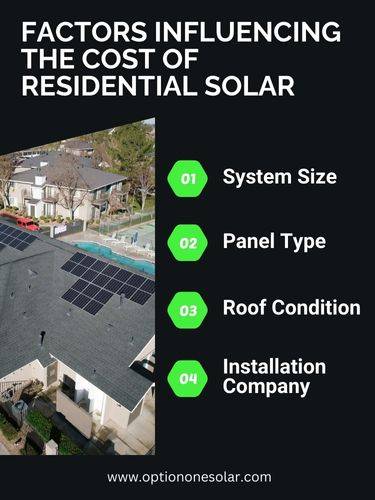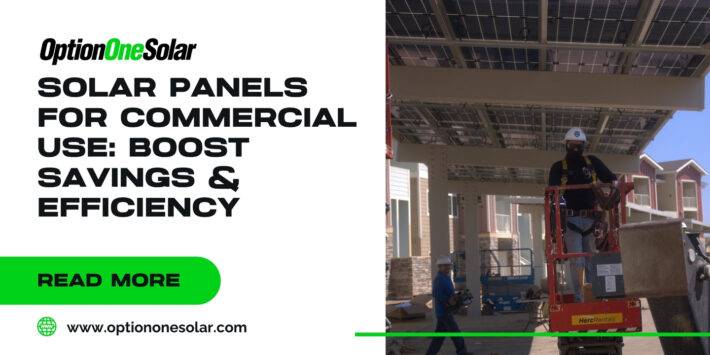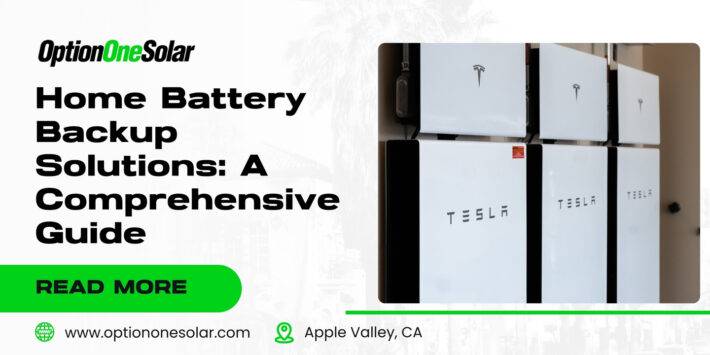Switching to solar energy is a bright idea, especially for homeowners looking for affordable residential solar solutions. With rising electricity costs and growing environmental awareness, moving to clean energy makes more sense than ever.
The sheer amount of information—from government incentives to different types of solar panels—can make going solar confusing. This guide is here to help. It explores several ways to make your journey toward affordable residential solar solutions easier to manage.
Ready to harness the sun’s power and reduce your energy bills? Contact OptionOneSolar today to find out how solar energy can be tailored to fit your needs.
Understanding Affordable Residential Solar Solutions
Affordable residential solar solutions involve solar panels, which convert sunlight directly into electricity. This system reduces your reliance on traditional power grids and potentially slashes your monthly energy bills.
Factors Influencing the Cost of Residential Solar
Finding affordable residential solar solutions starts with understanding the factors influencing their cost. Several factors can impact the final price tag on your solar system:
- System Size: Your home's energy consumption dictates the size and cost of your solar energy system. A professional solar panel installation companies such as Option One Solar will analyze your needs to determine the ideal system capacity for your requirements.
- Panel Type: The solar panel market boasts diverse types: monocrystalline, polycrystalline, and thin-film, each with distinct efficiency and price points.
- Roof Condition: Before installation, evaluating your roof's condition, age, and structural integrity is critical. If repairs or replacements are necessary, it will impact the overall cost.
- Installation Company: It is best to obtain multiple quotes from different solar installers as installation costs vary. Local installers like Option One Solar can offer varying price points compared to national providers.
Maximizing Savings: Exploring Financing and Incentives
Although the initial investment can feel substantial, the long-term financial and environmental benefits make it worthwhile.
Several financing options and government solar incentives can make these solar systems attainable.
Understanding your options empowers you to maximize your savings while joining the clean energy movement. Here’s what you should know about these:
Federal Tax Credit
Take advantage of the Residential Clean Energy Credit, which gives a 30% federal tax credit for solar system installations.
There’s no upper limit on the credit amount—any unused credit can be rolled over to future tax years.
Just make sure to file IRS Form 5695 along with your tax return to claim your credit, which can significantly offset your initial solar system investment.
Net Metering
Net metering, also known as net energy metering, involves feeding your excess solar energy back to the grid.
This generates credits to offset your energy consumption when your solar panels are less productive.
While California’s net metering structure shifted from NEM 1.0 and 2.0 to NEM 3.0, it remains a beneficial option for many, although it takes longer to recoup your solar investment.
If your rooftop solar power system exceeds your household needs, you'll earn credits. If your system generates less than you need, your utility company will provide power.
Net metering enables homeowners to reduce or eliminate their energy bills.
Property Tax Exclusion for Solar Energy
Californians enjoy a property tax exclusion for their solar panel installations, which is currently scheduled to expire in 2025. Adding affordable solar energy solutions to your property does not increase your property taxes.
Installation Process: What You Can Expect
Switching to affordable residential solar solutions does not have to be a headache. The installation process varies depending on several factors, including your location, chosen installer, and local regulations.
However, remember there will be variations based on your location, the chosen solar provider, and local regulations.
- Home Energy Assessment: This initial evaluation will calculate your energy usage. This helps determine your system requirements, exploring various system sizes and designs based on your roof space and orientation, identifying any shading concerns, and estimating potential savings.
- Choosing a Solar Installer: When selecting a contractor to install solar, it’s recommended that homeowners select a solar installer certified by NABCEP, like Option One Solar. They should also make sure their licenses and certifications are up-to-date.
- System Design: In the design phase, the chosen solar company customizes the solar panel system to maximize its effectiveness, factoring in the available roof space, its orientation, and any potential shading issues. Using advanced software to assess your energy usage helps customize the right solar energy system for you.
- Permitting: Applying for the necessary building permits from your local government authorities is the next step in the installation process. The solar installation company should have in-depth knowledge of this.
- System Installation: This crucial phase involves carefully positioning the solar panels and other components, like inverters and racking systems, on your roof.
- Inspections and Approvals: Inspections and approvals are vital to ensuring everything complies with safety codes, ensuring the new system adheres to electrical and building standards, verifying proper installation and system functionality, and activating your net metering agreement to monitor energy production and usage.
FAQs About Affordable Residential Solar Solutions
What are the benefits of installing a California solar roof?
Installing a California solar roof can significantly reduce your energy bills and increase your property's value. It also helps you take advantage of state incentives and contributes to a greener environment.
Will California Cover the Cost of Solar?
Depending on your income level, you may be eligible for a variety of government programs and financial incentives. These programs—including the federal tax credit and local rebates—can substantially minimize or eliminate your initial investment. Explore the Database of State Incentives for Renewables and Efficiency for current offerings in your area.
How do solar companies help with the integration of solar batteries?
Solar companies can guide you in choosing the right solar batteries to store excess energy generated by your panels. This ensures you have a reliable power supply even when the sun isn’t shining.
Is it still worth getting solar panels in California?
It’s understandable to wonder if installing a new residential solar system in California is still worthwhile, given that changes to the net energy metering (NEM) regulations impact reimbursements to customers who sell excess energy to the grid.
However, solar energy still offers advantages for reducing energy costs, contributing to environmental goals, and possibly increasing your property value, particularly with continued improvements in panel technology.
Empower Your Transition to Affordable Residential Solar Solutions
While switching to affordable residential solar solutions can initially seem complicated, understanding your options empowers you to save money while adopting greener energy sources.
Armed with the information this guide provides—including tapping into government programs and finding certified installers who offer the most competitive pricing in your area.
Your transition to clean, renewable solar energy is certain to be a smooth one.
Choose Option One Solar for the best residential solar solutions in Apple Valley, CA. Our expert team offers top-notch service and competitive pricing.
Contact us today for a free consultation and start saving with solar!






